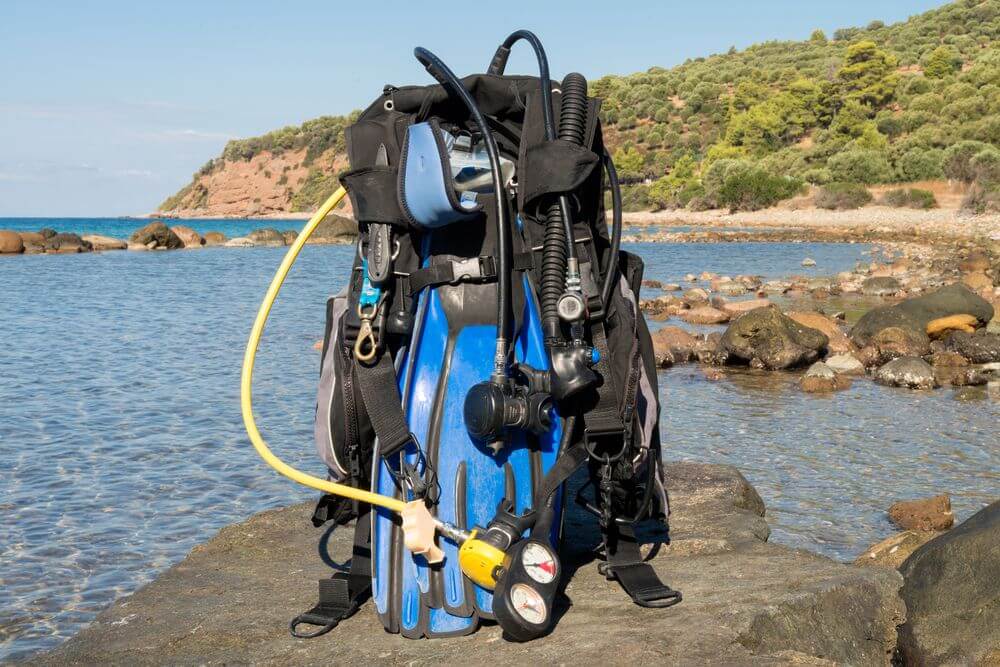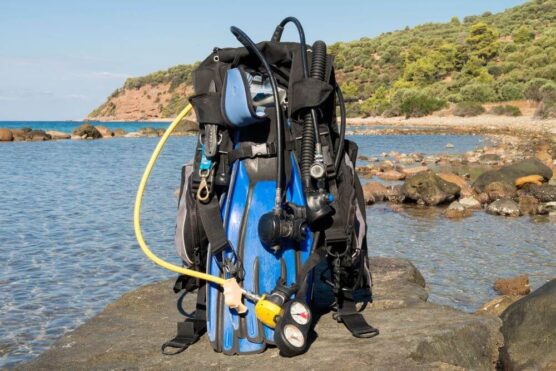
Squad! At ease for your mission briefing on how to choose the best BCD for beginners.
Get a shitload of this: In addition to different makes of bcd, there’s a load of different types as well!
For example, there’s women’s bcd’s, back inflate bcd’s, travel bcd’s…the list goes on!
In our best bcds for beginners guide we’re going to cover the different types of bcd , with a review of which model we consider to be the best version for beginners of each bcd type.
If you’re a total doob (dive noob), don’t even trip. We’ve also covered the bcd basics like what the hell is it as well as how to set it up and actually use the damn thing.
CONTENT:
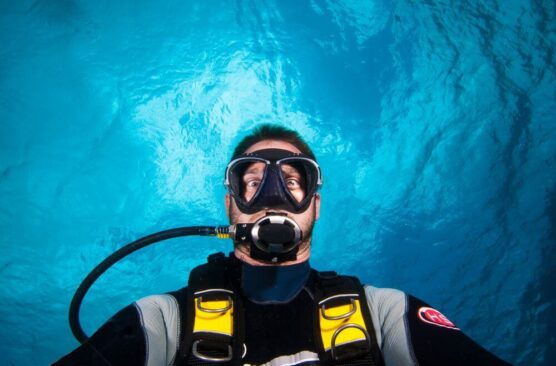
Jacket BCD’s
The Best Jacket BCD: Cressi Aquaride Pro BCD
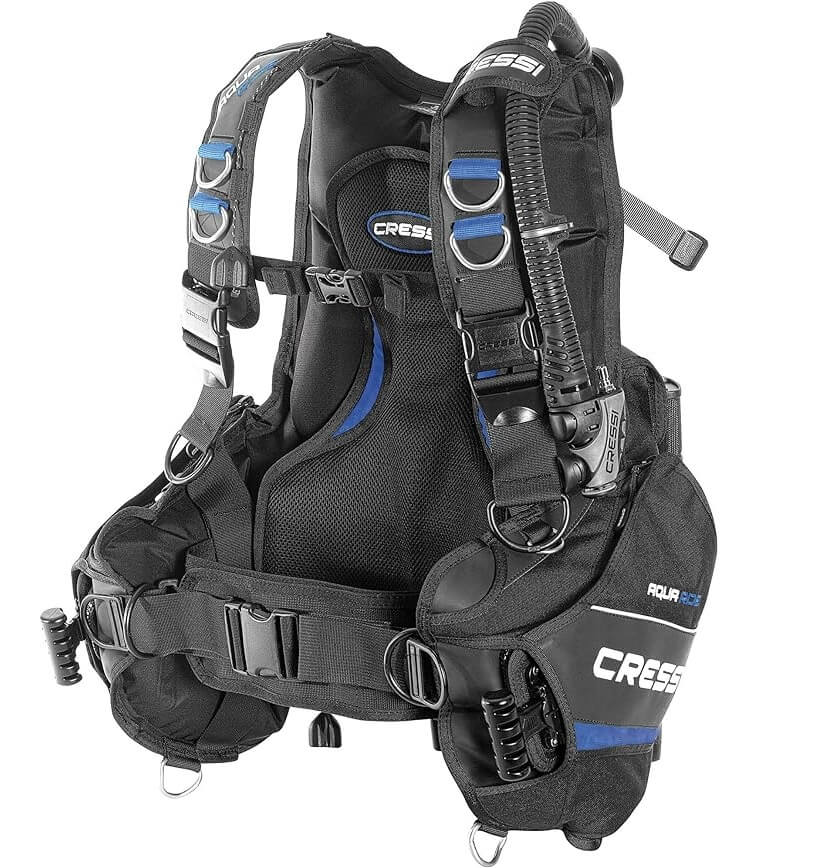
- $$
- Cressi are of the biggest underwater sport brands in the world.
- Great Comfort
- Insanely Durable.
- Adjustable Shoulder straps & Integrated Weight System
Cressi have a bulletproof reputation. As a brand, they started very early in the days of underwater sports and remain one of the biggest there today. The Cressi Aquaride Pro reviewed here, is used by most dive centres around the world which is testimony to it’s reliability.
That’s because it’s made from an incredibly tough material, specially designed to withstand daily professional use. On top of impressive durability, you are protected by a warranty that covers problems within a year of purchase.
Amazing comfort is achieved through adjustable shoulder straps, as well as an integrated weight system. The integrated weight system can hold up to 9 kgs (20lbs), which are stored in two large pouches on either side of the diver.
Each weight pouch uses the Cressi pocket lock system to secure the weights and includes a quick-release for emergency situations. On top of that, back trim pockets to help with weight distribution, while a variety of extra pockets and clips make the BCD a rather practical option. You should never run out of space for various accessories such as your dive light.
As Beginner BCD’s go, this is one of our favourite BCD’s out there. Rating: 4.9 / 5
What is a Jacket BCD?
Because nearly all divers learn to dive with them, Jacket BCD’s are actully one of the most common BCD types. They’re shaped like a sleeveless vest, with built-in air bladders surrounding the diver, usually from the front, back, and sides.
This style of Buoyancy Control Device is known for excellent stability, especially in a vertical position. This, along with its ease-of-use and general familiarity makes jacket style BCDs extremely popular amongst hobbyist divers.
While this style is objectively comfortable, some divers do not like the way it compresses one’s torso upon inflation, and prefer less bulky options such as back-inflate BCDs. Click here for a review of the best jacket BCD for beginners in 2025.
Back Inflate BCD’s
The Hands Down Best Inflate BCD of 2025: Zeagle Ranger
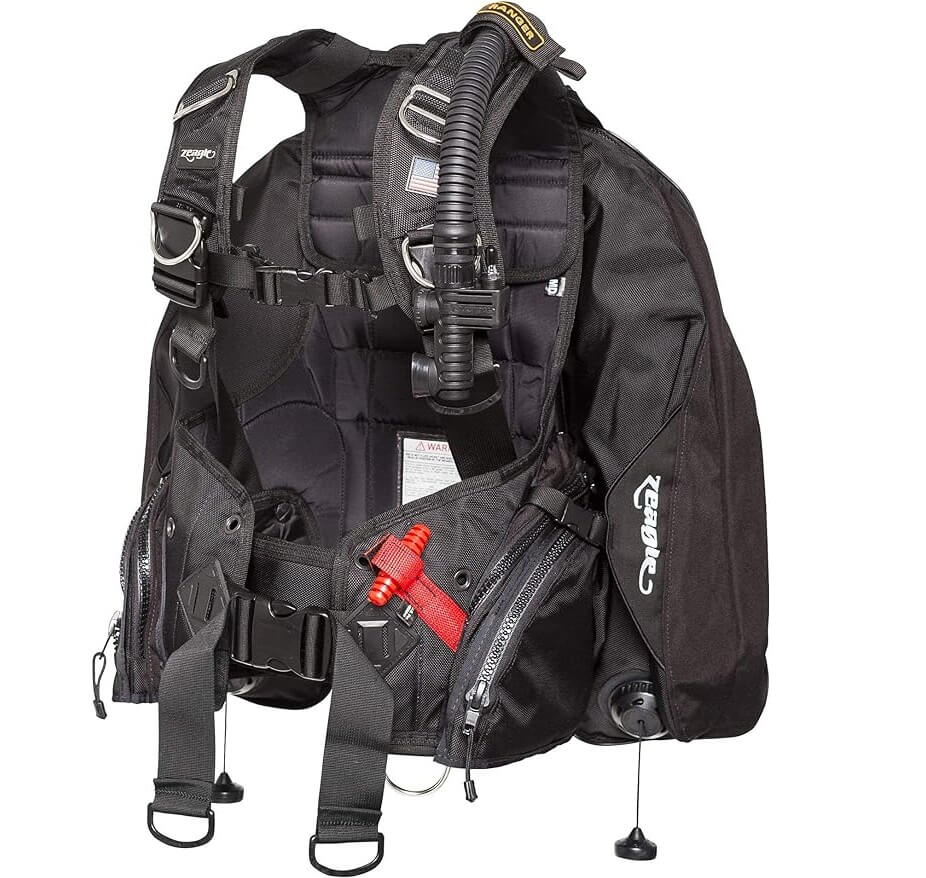
- $$$
- Personal Fit System for Ultimate Comfort
- Made from tough material
- Integrated Weight System
- 2 Zip pockets for Storage
- Heavy
Like the previously reviewed Cressi Aqualine, the Zeagle Ranger performs well on all fronts with its integrated weight system. The main difference is the position of the BCDs air bladders behind the diver.
For ultimate comfort and fit, Zeagle has included their Personal Fit System (PFS). This is a set of adjustable straps that allow you to adjust the BCDs size to perfectly fit your body shape. While the adjustable shoulder straps are seen on many modern BCDs, the sternum strap and stretchy cumberband set this BCD apart.
Made from the toughest materials, and tested in dive schools around the world, this setup is built to last. Furthermore, its customisable setup means that your BCD can evolve with your expertise and experience, eliminating the need to upgrade. Want to dive with a second tank? Easy! Need to improve your BCDs lift capacity with a second bladder? No problem!
With regards to storage, Zeagle has provided 2 zip pockets, large enough for nifty dive accessories such as your dive light. If this isn’t sufficient, you can clip your accessories onto one of the BCDs 6 D-rings. For me these clips are perfect, keeping my gear accessible at all times.
The only real downside of the Zeagle Ranger is its weight. At 3.8 kg (8.4 lbs) it becomes a little cumbersome for travellers, who often opt for lighter models that fold or compress more easily.
Our Rating: 4.7 / 5
What is a Back Inflate BCD?
A back-inflate BCD is similar to a BCD jacket, but has its air bladders located on the back rather than around a divers torso. For divers who feel squished when inflating jacket style BCDs, this is a welcome relief.
By relocating the air bladder, the chest area is decluttered, resulting in a more minimalist setup. This is especially popular amongst freedivers and spearfishing enthusiasts who are accustomed to diving without the burden of so much gear.
However, the main advantage of this type of BCD is the diving position it facilitates underwater. By relocating the air bladders, divers are more stable, floating in a horizontal position, which is often referred to as trim.
By improving trim, you become more comfortable and will improve your aquadynamics. While this comfort comes from a lower centre of gravity, your new streamlined diving position will require less energy and oxygen while diving, ultimately allowing you to dive for longer.
The only downside of such a setup is the floating position above water. While an inflated jacket-style BCDs keep you in a stable horizontal position on the surface, back-inflate versions tend to keep pushing you into a horizontal position, often submerging your face.
This issue can, however, be avoided by slightly deflating your BCD, or shifting your center of gravity backward. With a bit of practice, this is usually not a major problem, but is something to consider. If you are doing many shore dives requiring long swim outs, maybe this isn’t the best option for you.
Hybrid BCD’s
Ultimate Hyrbid BCD: Mares Hybrid
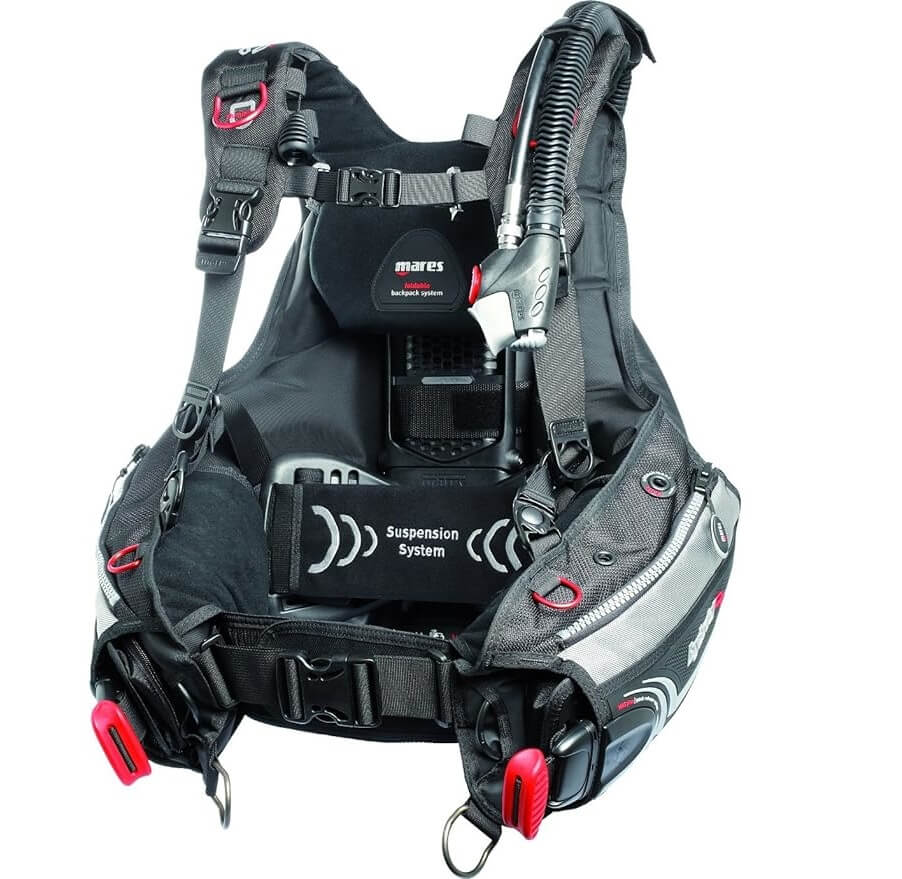
- $$
- Lightweight design & foldable backplates = ideal for travel.
- Durable.
- Freedom of movement
- Modular integrated weight system
For the Ultimate Hybrid BCD, we simply love the Mares Hybrid BCD. Like all hybrid BCDs, it combines a jacket-style BCD’s surface stability with a back-inflate BCD’s aquadynamic trim.
Its lightweight design and foldable backplate make it great for traveling. It’s also incredibly tough, using materials strong enough to stand the test of time and then some.
Mares quality guarantees that all the basics are covered, ensuring comfort, practicality, durability, and sufficient storage space.
The straps are adjustable from 3 points, meaning that you can mould the BCD to your body, nice and snug. Underwater, the BCD does not constrict your movements whatsoever. This is because the air bladder is not part of the harness, and the modular integrated weight system is extremely comfortable, giving you sensational freedom of movement.
Our Rating: 4.8 / 5
What is a Hyrbid BCD?
This type of BCD aims to combine the benefits of back-inflate and jacket-style BCDs by combining features from the styles of both.
By making use of air bladders at the back of the BCD, as well as around the torso, hybrid BCDs achieve horizontal stability underwater, as well as vertical stability at the surface.
This means maintaining your aquadynamic trim, while not having to deal with your face being pushed towards the water when you are at the surface. Furthermore, because the air bladders are spread around the back and torso, you will not feel squeezed once the BCD is inflated.
Otherwise, this style of BCD is much like your regular jacket-style or back-inflate BCD, with a variety of different options depending on the model and brand you choose. While some have an integrated weight system, others require weight belts.
Travel BCD’s
Diving Squad’s No.1 Travel BCD: Oceanic Biolite Buoyancy Compensator
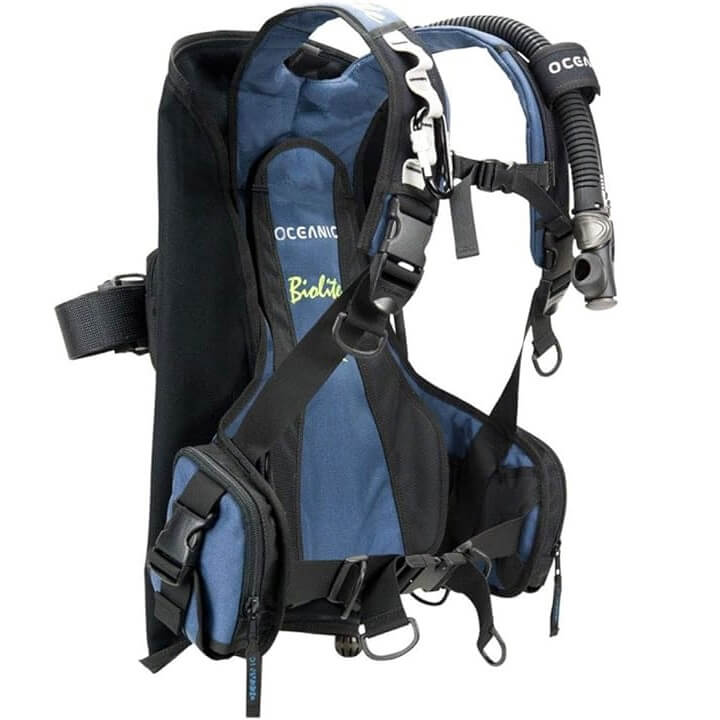
- $$
- Lightweight and easy to pack
- Shoulder and torso adjustment conforms this BCD to the shape of your body.
- Less bulky air bladders = reduced drag under water.
- Integrated weight system.
- Less Durable than other BCD’s
At just 2.5 kg (5.5 lbs), and with a compact design that is able to fold for easy storage, Oceanic has created a fantastic BCD for traveling divers.
Insane comfort comes from the Oceanic’s stretchy Bioflex material, as well as the shoulder and torso adjustment systems, which help the BCD conform to the shape of your body. These features help achieve a snug fit, a real necessity for comfort.
This same flexible technology is used with the air bladders, allowing smaller compartments to be used. These less-bulky bladders stretch when inflated, reducing drag and improving aquadynamics.
Moreover, the bladders are located at the back of the BCD, making the Oceanic Biolite BCD a back-inflate style BCD and further improving your aquadynamics.
Keeping up with the latest technology, this BCD includes a 6.5 kg (14.3 lbs) integrated weight system. This comes with an instant quick release system, as well as a 2.3 kg trim weight pocket.
Ultimately, this travel BCD provides ultimate practicality, with almost no sacrifice. At just 2.5 kg (5.5 lbs), and including all the latest bells and whistles, the only sacrifice is an integrated weight system that can hold slightly less weight.
Our Rating: 4.7 / 5
What is a Travel BCD?
The travel BCD niche is relatively new, but has recently exploded with increased amounts of travellers looking to bring diving equipment with them. They are regular BCDs, with small adjustments that make them ideal for the globetrotting diver.
This style of BCD is lighter than its counterparts, losing precious kilograms by substituting steel for plastic wherever possible, and removing the backplate.
The lack of a backplate also makes the BCD much easier to pack, as it is no longer rigid.
However, serious divers using their equipment on a daily basis, such as dive instructors, should steer clear of travel BCDs. Rather invest in more heavy-duty equipment designed to withstand everyday use and abuse.
Women’s BCD’s
The Best Women’s BCD of 2025: ScubaPro Bella
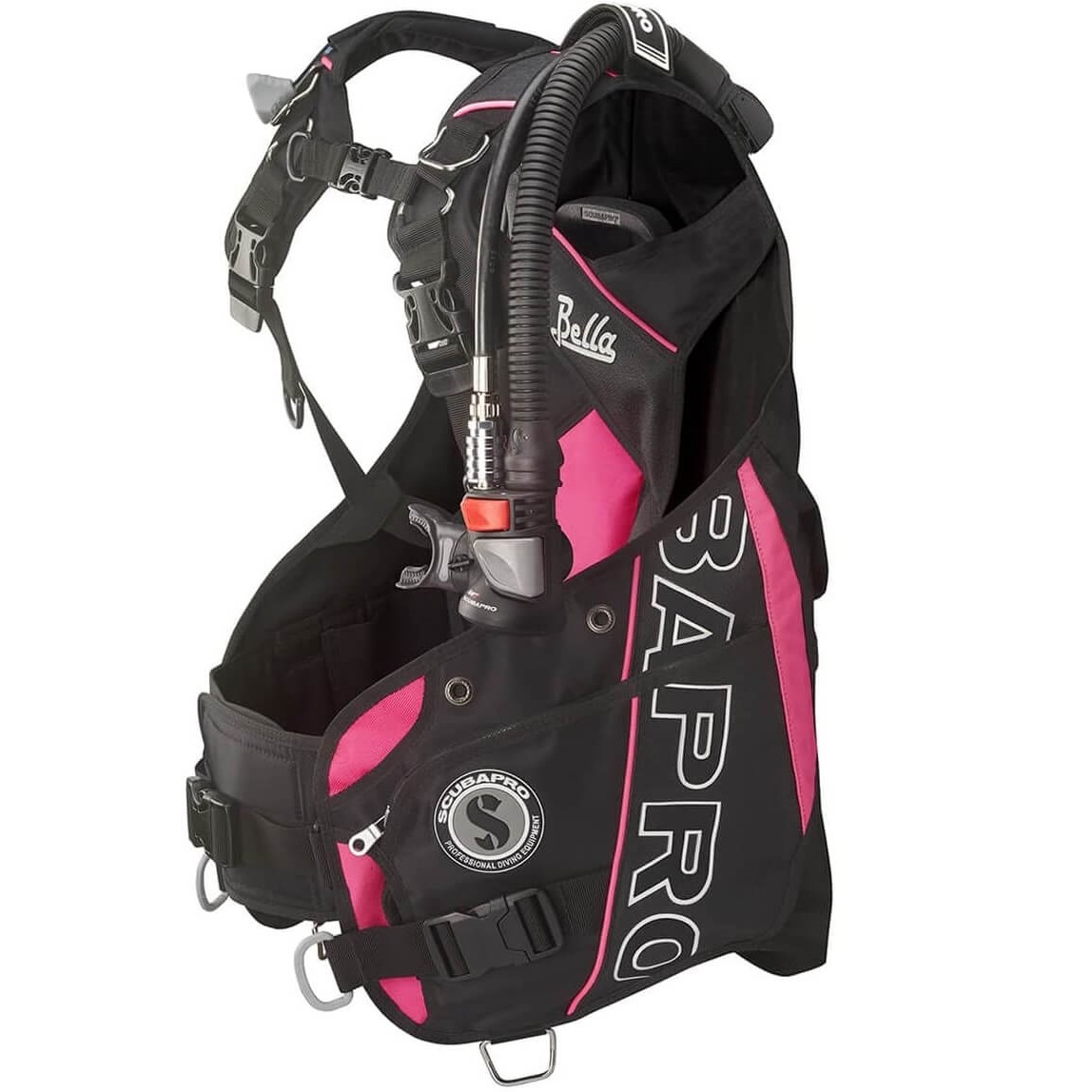
- $$
- Maximum fit and comfort for the ladies!
- Jacket Style BCD = stability at the surface
- Integrated weight system
- Large zipper pockets for storage
As a BCD designed specifically for women, the ScubaPro Bella guarantees a better fit than unisex models, thus maximising comfort. This effect is compounded by the self-adjusting buckle and stretchy cumberband that further helps this BCD morph to the shape of your body.
It is a jacket-style BCD, meaning stability at the surface, as well as familiarity for most divers. However, this means that those who feel constricted by air bladders around their torso may prefer a different option.
Although jacket-style BCDs are associated with an instability at the surface, this is combated with an integrated weight system that includes space for trim weights.
In total, the integrated weight system can accommodate just under 10 kg (22 lbs) and includes a quick release system for emergency situations.
And with regards to storage, large zipper pockets and D-rings create space for your dive light and any other small accessories. Ultimately this is a solid BCD that will serve you for many years, providing performance and tailored comfort.
Our Rating: 4.9 / 5
What is a Woman’s BCD?
Most BCDs are created as unisex products, and can work well for men and female. However, a BCD’s comfort is, to a large degree, determined by its fit.
This is why we strongly suggest that female divers stick to Buoyancy Control Devices specifically designed for their body shape.
A women’s cut is narrower around the shoulders and has a little extra and hip chest space, while the back plates usually have heavier padding. The result, a BCD that will mould around a female body, helping achieve maximum comfort.
Otherwise, female BCD’s are much the same as their male counterparts, with a variety of options and styles available. Read more about womens’ bcds.
Cheap BCD’s
Diving Squad’s Ultimate Cheap BCD
Cressi Start BCD
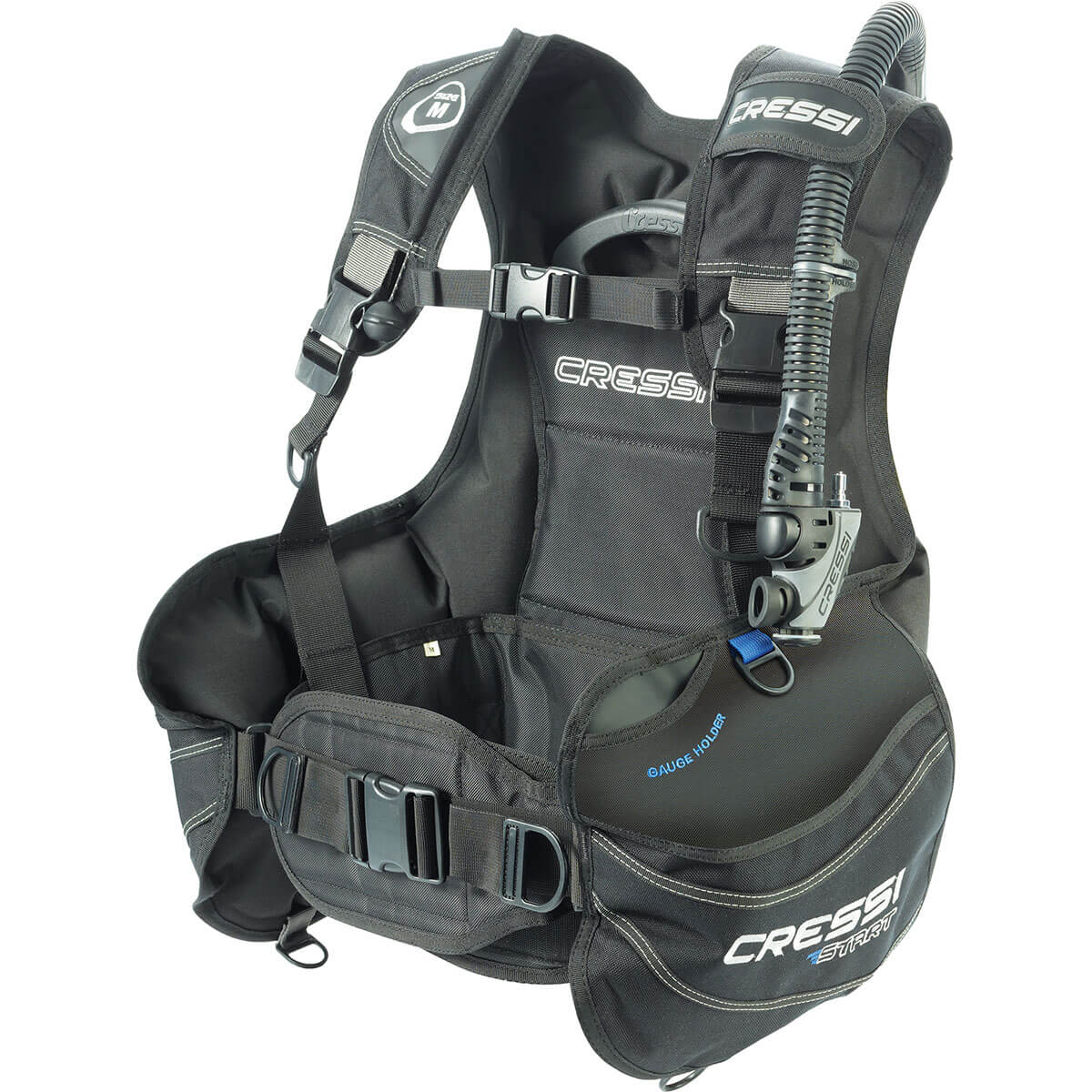
- $ – As cheap as a BCD get’s whilst still offering high quality.
- Made by Cressi – the biggest name in underwater sports.
- Exceptionally durable
- Large velcro pockets and D-rings for storage.
- Simple Setup
In 1946 Cressi founded what remains one of the biggest names in underwater sports today. With such a brand, quality is guaranteed, even with their entry level BCDs such as the Cressi Start.
The idea behind this BCD is simplicity, which translates into affordability, making this the perfect BCD for beginners. New divers will love how straightforward this model is, as well as the fact that it doesn’t require you to fork out an arm and a leg.
Although this model is more affordable than most other options, it will still stand the test of time. This is due to its tough 1000 denier Cordura fabric, which has proved itself much stronger than its nylon counterparts.
With regards to practicality, there are large, velcro storage pockets as well as D-rings to store everything you need. On top of all that, the air pockets are extremely easy to clean because of the inflator twin air filter.
The only downside to this BCD is a lack of integrated weights, but you can’t expect all the bells and whistles at such a low price. Furthermore, a weight-belt easily makes up for this deficiency. Ultimately, this BCD punches above its weight, providing quality at an extremely competitive price point.
Our Rating: 4.5 / 5
What’s a Cheap BCD?
When it comes to beginner scuba gear, while you don’t need to spend an arm and a leg on the latest hi-tech equipment, you want to stay well clear of cheap off-brand knockoffs. Ultimately, you will keep this gear for years to come and should purchase with a long-term outlook.
We would suggest you slowly accumulate quality dive equipment, building towards a full set. This would serve you better than investing in a more-affordable full-set of diving gear that will need replacement in a couple years.
Furthermore, you will need to have confidence in your gear, as faulty equipment is dangerous, potentially leading to disaster. Ultimately, this is why we suggest sticking to reputable brands known for long-lasting quality. Read more about Cheap BCDs.
BCD Setup and Buyers Guide

Your first challenge will be to decide on a style of BCD. This is a personal choice, that comes down to your specific diving needs.
These needs are determined by where you dive, what type of diving you do, and any equipment you already own.
Fortunately, the suitability of each BCD style is analyzed throughout this article in the previous sections.
If you already have a regulator setup or have one you are planning to acquire, bear in mind that you’ll need to choose from BCDs that are compatible with it. Otherwise, you are ready to go shopping.
When looking for BCDs, how the item fits is the main consideration. This comes down to how comfortable your BCD is, and if it is the right size. Remember to account for the thickness of your suit when deciding on a size. Furthermore, divers who wear gloves will benefit from bulkier clips, buttons, straps, and releases.
Otherwise, your choice will come down to extra features, affordability, brand preferences, colour, and aesthetics. As long as you remember to prioritise comfort and suitability, you should end up a happy customer.
What the hell is a BCD and how does it work?
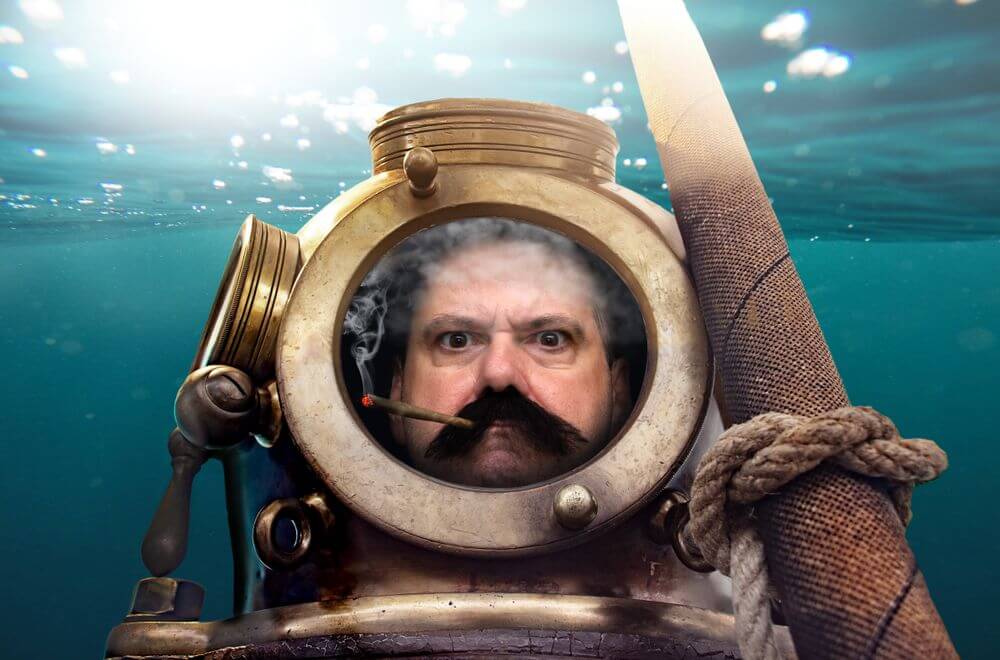
Very simply dear reader, a BCD is an inflatable device that provides divers with increasing buoyancy as its air bladders are filled with air.
It is a vital piece of diving equipment that allows scuba divers to ascend, descend, or maintain their depth.
While one button causes a sudden burst of air from a diver’s tank to inflate the BCD, another releases bubbles, deflating it.
A correctly weighted diver will have a slightly negative buoyancy, and therefore needs a BCD to prevent himself/herself from sinking like the Titanic.
At the surface, one’s BCDs are inflated, keeping divers positively buoyant. Then, in order to achieve negative buoyancy and descend, they are deflated.
Once divers reach their desired depth, a short burst of air is needed to ever-so-slightly inflate their BCD and achieve neutral buoyancy.
Constant adjustment is then required underwater because as divers venture deeper below the surface, underwater pressure increases. This pressure compresses your wetsuit, as well as the air in your BCD’s bladders, ultimately reducing buoyancy.
At the end of a dive, when it’s finally time to resurface, divers will carefully add air to their BCD until they begin to inch towards the surface. This is done in an extremely controlled manner to avoid decompression sickness.
Other Types of BCD
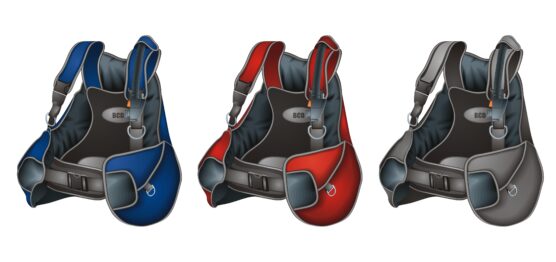
Types of Scuba BCD – More than just Different Colours
Technical BCD’s
Technical divers are highly qualified and involved in advanced dives such as cave dives, wreck dives, night dives, and solo dives. These divers require specialized equipment, usually more robust and expensive than regular BCDs.
A hard backplate and inflatable are permanent fixtures of technical BCD rigs, however, the other components are optional extras. Each piece of a technical BCD is detachable, allowing divers to customize their setup to suit every dive’s specific needs.
This type of BCD is generally used by rescue personnel, cave divers, professional underwater cave welders and the-like. It provides ultimate versatility, but requires foresight before each dive, and is therefore not suited to beginner divers.
Don’t worry yourself with such a complex piece of equipment to start off. Rather just enjoy becoming comfortable in the ocean, to begin with.
Sidemount BCD
A sidemount BCD is a type of technical BCD, first used by cave divers. By attaching a tank either side of the diver, they remove the need for two cumbersome tanks to sit on a diver’s back.
By making a diver smaller underwater, the exploration of tight spaces was made easier. Furthermore, this design improves aerodynamics, effectively allowing you to dive for longer.
Again, it would better for beginners to stick with jacket, back-inflate, or hybrid style BCDs.
Diving Squad DEBRIEFING:
You should be ready to pull the trigger and invest in your first BCD. There is no outright best BCD for beginners, as each type of diver has specifics need. However, we have summarised the best BCD for any occasion.
While travelers will opt for a lightweight design, women should go for something specifically designed for their body shape. On the other hand, those looking for surface stability should stick with hybrid BCD’s, while others looking for the perfect underwater trim would be better off with a back inflate BCD.
Ultimately, as long as you stick to reputable brands, avoiding the temptation to go with lower-quality, cheaper BCDs you will be alright. Remember that your BCD is a long-term purchase, something you will use for many years to come. Choose Wisely! Diving Squad Out.
Support the Squad!
We are part of the Amazon Services LLC Associate Program. If you make a purchase on amazon after clicking a link on Diving Squad, we earn a small commission fee, at no extra cost to yourself.
We are also part of several other affiliate programs so if you click on a Diving Squad affiliate link that results in you booking a liveaboard, booking accommodation, purchasing insurance or buying a product somewhere else, once more we make a small commission, without it costing you a cent extra. Thanks!
